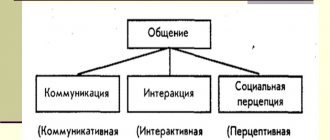The culture of communication occupies a dominant position in human culture. It is able to determine the verbal and non-verbal behavior of people, as well as the choice of lexical and grammatical means in appropriate communicative situations.
However, before talking about the cultural component, it is worth defining the concept of communication as a communicative activity.
The concept of speech etiquette
From childhood, parents, educators, teachers, nannies instill in children good manners of speech, talking about the rules of behavior in society. Speech etiquette is part of the general rules and norms of behavior. In the age of computer technology, live communication has been replaced by virtual communication. A whole slang trend has emerged - words used only on social networks. For example, “preved”, “krosavcheg”, “ok”. The new generation has stopped thinking about what speech etiquette is. However, for a successful career, it is important to be able to communicate, show your best side, and be able to convince of your knowledge in order to take a leadership position. To do this, you need to adhere to the rules of speech etiquette, understand what situation you are in, and what needs to be said in a certain situation.
Rules for successful formal communication
The main thing is no familiarity. Flirting between business partners is also excluded. Interlocutors must find the perfect balance between polite detachment and polite involvement. The first should not turn into arrogance, the second into obsession.
You should not adhere to the picture's officialdom. At a business meeting, there may well be appropriate jokes and conversations on abstract topics. Getting personal is taboo, it’s rude and can offend your interlocutor.
Punctuality, commitment and honesty. When creating a first impression, there are no trifles - don’t be late, don’t be rude to the staff.
Business communication is different in that it does not contain fragments that hint at personal topics. This communication is to the point - polite, courteous and impartial, but at the same time inviting. It is aimed at achieving mutual understanding and contact.
Official communication provides for the following rules:
- manners and speech in accordance with the specific situation;
- extreme clarity of speech - clear pronunciation, clarity of presentation;
- reliability of information;
- correctness;
- moderation;
- attentiveness;
- maintaining distance.
A little history
Problems of speech culture were raised already in the 4th century BC. Disputes among philosophers on the merits and demerits of speech led to the formation of a whole direction - rhetoric. Scientists and philosophers worked on scientific treatises, which outlined recommendations on the appropriateness of speech patterns and how to learn expressive speech. This is how the history of speech etiquette was formed.
In Russia, the scientist Mikhail Lomonosov was the first to draw attention to the development of eloquence and the concept of speech etiquette. He put forward a number of theories about the development of the skill of oratory, the ability to appeal with words in the scientific, literary environment and ordinary everyday life. His efforts were not in vain, because attention to speech and communication culture led to the development of a single literary language without dialects, local accents, or common sayings.
Culture of verbal communication
The culture of a person is most colorfully and naturally expressed in her speech. As a rule, the first idea and opinion about an individual is formed on the basis of the impression that arises as a result of communicative interaction with him from his speech manner. Nurturing a culture of communication is considered in modern society as one of the most important tasks of education, which is associated with the development of the native language. After all, mastery of the entire wealth of the literary language, competent use of its visual and colorful means determine the degree of verbal competence of an individual and is the clearest indicator of his general culture.
High cultural speech lies in the ability to correctly, competently, clearly and expressively convey one’s own thoughts and worldviews through the means of language. It also covers the ability to find simpler, more intelligible formulations, more appropriate means suitable for a particular situation, tools for arguing a position or point of view. Cultivated speech obliges an individual to comply with mandatory norms, techniques and rules, among which the core ones are: content (essence), logic, validity (evidence), persuasiveness (argumentation), clarity (preciseness), intelligibility.
Content (essence) represents the thoughtfulness and maximum information content of the remarks. After all, the art of rhetoric lies precisely in being able to say everything that is necessary, but no more.
Logicity consists of validity, absence of inconsistency and consistency of statements in which the leading theses and expressions are connected and subordinated to a single position, thought.
Evidence (validity) lies in the reliability of the arguments, which must clearly demonstrate to the dialogue partner that the discussed topic or subject of conversation exists in reality and is objective in nature.
Persuasiveness (reasoning) is expressed in the ability to convince a partner and achieve a strong rooting of this belief in his consciousness.
Clarity (clarity) accordingly implies clarity and clarity of speech. Excessively fast speech is usually difficult to understand, and excessively slow speech will only cause irritation. Speech characterized by dullness and inexpressiveness will cause boredom and lead to the death of even the most thoughtful statements.
Clarity lies in the use of terms, concepts, words that will be understandable to the interlocutor.
Functions
- Communication is the leading function of speech etiquette for communication between people.
- Stylistic - the concept of the style of language and speech.
- Normative - about the norms of language and speech, unacceptable vocabulary, the laws of everyday and business speech etiquette.
- Exemplary - templates for the best oratorical speech.
- Cognitive – through the principles of speech etiquette, understanding the world around us.
- Cumulative - accumulation of knowledge about the culture of the language and speech etiquette in order to improve the connection between generations.
Language of the body
Gestures and facial expressions make speech livelier and brighter. Non-verbal communication is also governed by decorum. The ability to maintain posture and monitor one’s movements often helps to move up the career ladder and always plays into a person’s hands:
- Straightened shoulders, a raised chin and a straight back are associated with lightness and a peaceful attitude.
- When sitting, men should not lie back and spread their legs. Women must keep them together, the opposite sex has the right to cross their legs. A straight back, no swaying or crossed arms indicate confidence and composure.
- Moderate gestures are acceptable in a business setting; there are no restrictions in everyday life.
- Head movements should not be limited to an unambiguous nod, but excessive activity is also undesirable.
Facial expression greatly influences interlocutors, so the main emphasis should be placed on it. To be convincing, it is enough that the facial expression matches the information being expressed. It is inappropriate to be disingenuous and “ambiguous” with the help of facial expressions, for example, when giving a compliment and at the same time wrinkling your nose.
Kinds
External speech is divided into groups:
- Spoken speech etiquette includes a lot of varieties, starting with conversational speech at the everyday level. This also includes a business style of communication, scientific speech as a way of dialogue between scientists, public figures, and philosophers. Artistic speech is expressed in teaching and in theatrical performances. Publicistic speech is aimed at conveying information and telling stories about events.
- Written - displaying oral speech in writing text. It is important in terms of preserving information and transmitting it through generations.
- Monologue - a monologue by one speaker who is listened to by a large audience. Adhere to the etiquette of verbal communication at conferences, seminars, and in speeches by coaches.
- Dialogical - a dialogue between people on a specific topic that both interlocutors know and understand. Dialogue speech is replete with a set of specific expressions and technical terms related to this topic. People around you who don’t know what you’re talking about may not understand the essence of the conversation. But both interlocutors follow all the rules of speech etiquette during a dialogue that concerns only them.
- Inner speech. Identified based on the level of education and self-education. This is a person’s ability to listen, perceive and pass through the information received. The ability to think, analyze the situation within oneself, without resorting to written and oral speech. Internal speech is a continuation of external speech, only in silent mode. A person thinks before answering a question, expressing his opinion, and compares information within himself in order to teach it correctly. Inner speech depends on the development of the intellect, on the basis of which the development of speech in a person is judged. Any thought is formed with the help of inner speech, despite the fact that a person expresses it or keeps it to himself.
Formation of a culture of communication
The formation of a culture of communication is considered one of the highest priority areas of education, both in the family and at school. After all, it is the processes of education and upbringing that are focused on the development of the individual as a subject of personal life activity. The culture of pedagogical communication is designed to develop theoretical and practical foundations for the formation of a general culture of communicative interactions among students. And the ability to competently construct one’s own speech, interact with others, and correctly build interpersonal relationships allows parents to effectively instill in their children cultural communication skills.
At the level of the average person, the culture of communication and behavior is understood as a unique model that individuals should emulate. Sometimes a person’s culture is associated with his education, intelligence, intelligence and is qualified as a certain personal property. However, at the level of theory, culture is a specific characteristic of society, expressing the degree of historical development achieved by humanity, determined by the attitude of the individual to the environment and society. Also, many perceive culture as the creative self-expression of the individual and society as a whole.
In turn, there is an understanding of the cultural character of an individual as a set of material, spiritual guidelines and values, characteristics of the degree of its development, creative activity in the production, storage, assimilation and transfer of values. In a broader sense, culture is a stable personal characteristic that covers ideological and axiological aspects and determines its relationship to the environment.
Communication is the process of interconnection and relationship between subjects of society, which can be individuals and social groups.
The need for communicative interaction is inherent not only to people, but also to most living beings. Initially, this need in a baby is similar to the need of animals, but quite soon in the process of development it acquires a human character. Communication among children is closely related, in turn, to understanding what adults want from them.
In the course of communicative interaction, the vital activity of the individual and society is ensured, the structure and internal essence of social subjects is transformed, the individual is socialized and transformed into a personality, as a social entity endowed with consciousness. It is communication that is responsible for collective activity.
The essence of communication culture includes the provision of a certain communication technique responsible for interaction. Moreover, during such interaction, individuals must not only not interfere with each other, but also maintain personal dignity and personal individuality.
A system of personally significant moral guidelines, which have become the internal beliefs and views of an individual, is called a formed culture of communication. An inevitable condition for the effective implementation of cultural communication is considered to be mastery of the means of interpersonal interaction under various life conditions and circumstances of the social environment. Objective indicators of the formation of cultural communications are certain personality traits and her actions, actions that are harmoniously consistent with the requirements of morality, morality, spirituality and etiquette.
The culture of communicative interaction is a complex, diverse process of formation and development of relationships, various contacts between individuals, generated by the needs for mutually directed activities, which includes the exchange of messages, the formation of a unified concept of interconnection, perception and comprehension of another person.
We can identify 6 priority areas, goals and objectives for creating a communication culture, which consist of developing:
- sociability as an individual stable personality trait;
- high level of personal relationships;
- high level of group development;
- high level of integration of jointly directed activities;
- academic performance and, as a consequence, social activity in the future;
- ability to quickly adapt to various types of activities - educational, gaming, professional, etc.
Speech etiquette formulas
A high level of speech culture helps to gain the favor of your interlocutors, form a correct opinion about yourself, and achieve career growth. How to behave correctly when meeting someone in order to form a pleasant opinion about yourself and not alienate your interlocutor? Learn simple speech etiquette formulas.
Getting to know each other - establishing contact
Any dialogue between acquaintances and strangers begins with a greeting. This is followed by a question or an offer to get acquainted with the goal of establishing contact. What does this look like in real life? In such cases, you can address a stranger with a phrase according to the rules of communication etiquette.
- Let's get acquainted.
- Let me get to know you.
- I can meet you.
- I'd like to meet you.
Conversation is the main part of communication
Conversations in an informal setting are possible on any topic and from any angle, if they are interesting to the interlocutors. Attending public events is regulated by certain communication etiquette, which is recommended to be observed so as not to be branded as an ill-mannered person.
The basis of speech etiquette is the rules of behavior at corporate and public events. It is not recommended to host or support topics about politics. The situation threatens to turn into heated debate, which leads to resentment, spoiled mood and irritation. In society, it is customary to talk about neutral topics - about books, concerts, films, music, performances. Conversations on the topic of personal relationships are tactless. Questions about this are indecent. Talking about your personal life puts your interlocutor in an awkward position.
Farewell - ending contact
Social etiquette requires saying goodbye before leaving. Leaving society in English without saying goodbye is not customary in Russia. To do this, it’s enough to say goodbye. You can add phrases with wishes to your farewell: all the best, all the best, I hope to see you again.
Speech culture and business communication
The lion's share of any manager's work process is taken up by various negotiations, conferences, appointments, and telephone conversations, so it is impossible to do without the ability to interact competently, business communications skills and knowledge of the cultural characteristics of speech.
In addition to everyday business communication, the career growth of many specialists directly depends on the ability to structure a conversation in accordance with the norms of speech culture and the principles of business communicative interaction. Otherwise, the dialogue may be directed in a completely different direction and instead of signing a profitable agreement, you will end up with a meaningless conversation. Unprofessionalism in conducting a business conversation also leads to the fact that the interlocutor will form an unfavorable opinion about the “speaker” and about his business qualifications. This is why you should take acquiring business communications experience and skills very seriously.
It so happened historically that in our time almost no one adheres to the correct construction of phrases during a friendly conversation, few people pay attention to the literacy of speech. Unfortunately, today there is such a tendency in communication that most people during a conversation strive only to convey the general meaning, without paying attention to the correctness of the construction of phrases, or to the emphasis in words, or to the correct pronunciation of these words. If now such a manner of conversation is acceptable in everyday life, then in business etiquette such an approach is absolutely unacceptable.
The success of business communications is influenced by many factors, such as: style of speech, its intonation, facial expression, body position, appearance, etc. That is why the stereotype of communication and the cultural speech of a business person depend on compliance with a number of certain rules, without following which an individual will never not to become an eloquent and skillful speaker. Below are the main ones.
♦ A business person must have a large and varied vocabulary, which will allow him to easily play and manipulate words, giving his speech effectiveness and richness. After all, it is extremely difficult to beautifully express your own point of view or prove the correctness of ideas without a diverse vocabulary.
♦ The structure of speech is also important. You should adhere to the “purity” of speech, which can be diluted with professional terms. It is not recommended to use jargon or unliterary statements in business communications.
♦ Literacy is the most important component of a culture of communication. Phrases must be composed taking into account the grammatical and stylistic rules of speech.
♦ When communicating in business, you should definitely pay attention to your pronunciation and intonation. After all, often others cannot grasp the correct meaning of phrases due to speech defects of the “speaker” or his inability to highlight the most important points using intonation. We should also not forget about the importance of non-verbal components of speech. Incorrect gestures, posture or facial expressions can ruin even the most successful presentation or brilliant speech.
To summarize, we can conclude that the ability to clearly, competently and eloquently express one’s thoughts is absolutely irreplaceable in the modern world of business and professional activity.
Various situations
Let's consider ordinary everyday situations that happen to everyone, but not everyone knows how to behave correctly. To avoid becoming a subject of ridicule and receiving snide remarks about poor upbringing, pay attention to standard sets of sentences.
Congratulations and gratitude
The standard words of gratitude are: thank you and thank you. You can get by with them or add many epithets. The main thing is to speak sincerely and not repeat the same thing ten times. As a result, the quality of what is said is lost. Gratitude comes with an expression of emotion - I am touched, so pleased, very grateful.
Congratulations according to the rules of speech etiquette in an official setting sound like this:
- Please accept my congratulations.
- On behalf of or on behalf of you, we congratulate you.
- Let me congratulate you.
During personal family holidays or on an anniversary, it is customary to say:
- My heartfelt congratulations.
- I want to wish you with all my heart.
Invitation and proposal
According to communication etiquette, invitations to special or family events differ. For public events, it is mandatory to issue invitations in paper form and back them up with words - we invite you. An invitation to corporate events is considered semi-official. To do this, it is enough to gather the team and say: “Come to the celebration, which will take place at the specified time.” An informal invitation to relatives and friends is based on the principle - come to my birthday. A personal meeting is not required, just a phone call.
Expressing suggestions and wishes is typical for managing your subordinates. Such things should happen in the correct form, without a commanding tone. For example, I want to advise you or would like to suggest.
Condolence, sympathy and apology
Speech etiquette prescribes the behavior of people when it is necessary to support a person in a difficult situation. In the case of a funeral, it is customary to offer condolences in simple words. When expressing sympathy, phrases aimed at encouragement are used: I understand you, it’s okay - it happens to many people, you did the right thing, don’t be upset. According to etiquette and culture of communication, an apology for an offense is unacceptable in an arrogant tone with a favor.
Compliments and praise
A compliment is expressed by a standard phrase, which is supported by additional words depending on the level of proficiency in speech etiquette. Compliment and praise always go hand in hand and are perceived equally. Typical examples of phrases:
- You look great.
- You are a good specialist.
- You are so witty.
- It's a pleasure doing business with you.
Basic rules and principles
Speech etiquette refers to a number of norms and rules of communication in society. In simple terms, this is the ability to communicate politely and tactfully in any situation.
The way speech is constructed, the words and expressions used are influenced by a number of factors: the age of the interlocutor, the situation, political and religious restrictions. The ability to appeal to all this allows you to build strong, trusting relationships with colleagues, friends and family.
By the way a person speaks, one can draw certain conclusions about him.
Speech is an indicator of education, social status, erudition and literacy. Over several centuries of its development, a lot of rules have accumulated that regulate social contact. It is completely impossible to voice and list them, but it is worth highlighting the rules of speech etiquette, which are considered basic:
- Politeness. It's always nice to talk to someone who doesn't forget about the rules of decency. Such an interlocutor wants to subconsciously correspond and respond to his “Good morning” with a smile and a similar phrase. Politeness helps out at work when people who are unpleasant to each other come together in one team. This ensures a healthy work environment and ensures that all employees feel comfortable.
- Following social standards. To feel like a full-fledged part of society, you must adhere to generally accepted norms of behavior. Otherwise, there is a high risk of non-acceptance by society and moral injury.
- Compliance with speech formulas. Cultural speech is impossible without structuring. Before the conversation begins there is a greeting, and at the end there must be a farewell.
- The ability to avoid conflicts. A healthy discussion or cultural dispute keeps the interlocutors interested in the topic of dialogue, and outright scolding goes beyond the bounds of a decent form of contact. The ability to say “sorry” in a timely manner will help smooth out the intensity of passions and return the vector of the conversation to a calm direction.
- Allocation of level between speakers. With close people, mutual contact is more relaxed; warm words and addresses are acceptable: “Hello,” “I’m very glad to see you.” Interlocutors in a less intimate circle prefer to limit themselves to the official phrase “Good afternoon.”
Politeness shows a person’s level of education, but it is not enough to take a worthy place in society. It is necessary to develop correct communication skills and fight shyness in order to correct the situation. Regular language practice and self-education will help with this.
National traits
A feature of speech etiquette in Russia is the obligatory address to a stranger, business partner, or work colleague. The transition to “you” is possible in such cases with the mutual consent of all persons who communicate with each other. Addressing “you” is common among relatives, friends, classmates at school, classmates in educational institutions. It is unacceptable to address teachers and teachers in kindergartens as “you”, both from students and pupils, and from their parents. It is incorrect to use “you” in relation to doctors, police officers and other representatives of professions to whom people turn for help. Subordinates may only address their superiors using “you.” The manager's address to subordinates is not strictly regulated.
Linguistic and behavioral means
Speech is mostly words and other sounds, of course, but there are other means of expression. For example, gestures and position in space relative to your interlocutor.
All this is also very important and has significance both from the secular side and in terms of national characteristics, which are also taken into account.
The clearest example of a behavioral tool can be considered gesticulation. This is a completely normal phenomenon - gestures are used by a person as “amplifiers” that complement speech.
They are used to express emotions and send super-fast signals. There are quite strict rules regarding gesticulation, mainly they involve restraining it.
There is nothing wrong with pointing your palm to your interlocutor for a conversation or with a gesture inviting him to enter the room, but waving your arms and closing the distance with a person without his consent is unacceptable.
Linguistic and behavioral means are inextricably linked, but the former exist without the latter, and vice versa - not.
In speech etiquette, the first assistants are linguistic and behavioral means. These include:
- moderate gestures and facial expressions;
- communication distance;
- expressed goodwill and restrained emotionality;
- demonstration of interest;
- avoiding controversial situations;
- non-categorical nature of one’s own statements;
- exclusion of disapproval;
- avoidance of excessive interest in personal details;
- participation in general conversation;
- brevity and uniformity of communication with everyone;
- minimum information about yourself;
- discussion of neutral topics - children, animals, weather, travel;
- helping your interlocutor in a delicate situation;
- expressing disagreement by remaining silent, asking a question, or switching to another topic;
- moderate use of humor;
- ban on sarcasm;
- exclusion of rude and colloquial expressions;
- positive mood;
- compliance with time frames and frequency of communication.
What it is
With the help of competent communication, a person exchanges information, avoids conflict situations, and receives advantages. Everyone needs this skill for a successful life.
The rules of cultural communication have changed repeatedly throughout the existence of mankind. This made it possible to generate such personal qualities as politeness, tact, and compliance. Standards of behavior are reflected in the rules of etiquette.
Features and structure
Not every communication will be cultural. Experts identify several specific signs:
- To be accepted by a certain group of people, a person follows strict rituals.
- The addressee perceives the execution of etiquette as a social “stroking”.
- There is a speech act, i.e. communication.
- Rules of politeness are observed.
The structure of cultural communication is quite simple. With the communicative side of the conversation, information and feelings are exchanged, with the interactive side, an exchange of actions occurs, with the perceptual side, the process of getting to know each other begins to establish strong social connections.
Researchers' opinion
It is the existence of culture that separates human society from the natural world. In axiology, it is believed that this term conceals a set of material and spiritual values that were created by people. The systems approach is different. In it, culture is the concentration of the qualities of humanity. It also includes the products of his activities.
M.S. Kagan believed that culture is everything that makes a person human
In psychology, this term refers to the properties of a person that reflect her worldview, attitude towards other people and the world. The concept can refer to both an individual and a group of people. Cultural communication is an important component of society. Without it, conflicts, quarrels, and clashes will begin among people. Each nation has its own ideas about politeness; this must be taken into account when contacting a foreigner.










